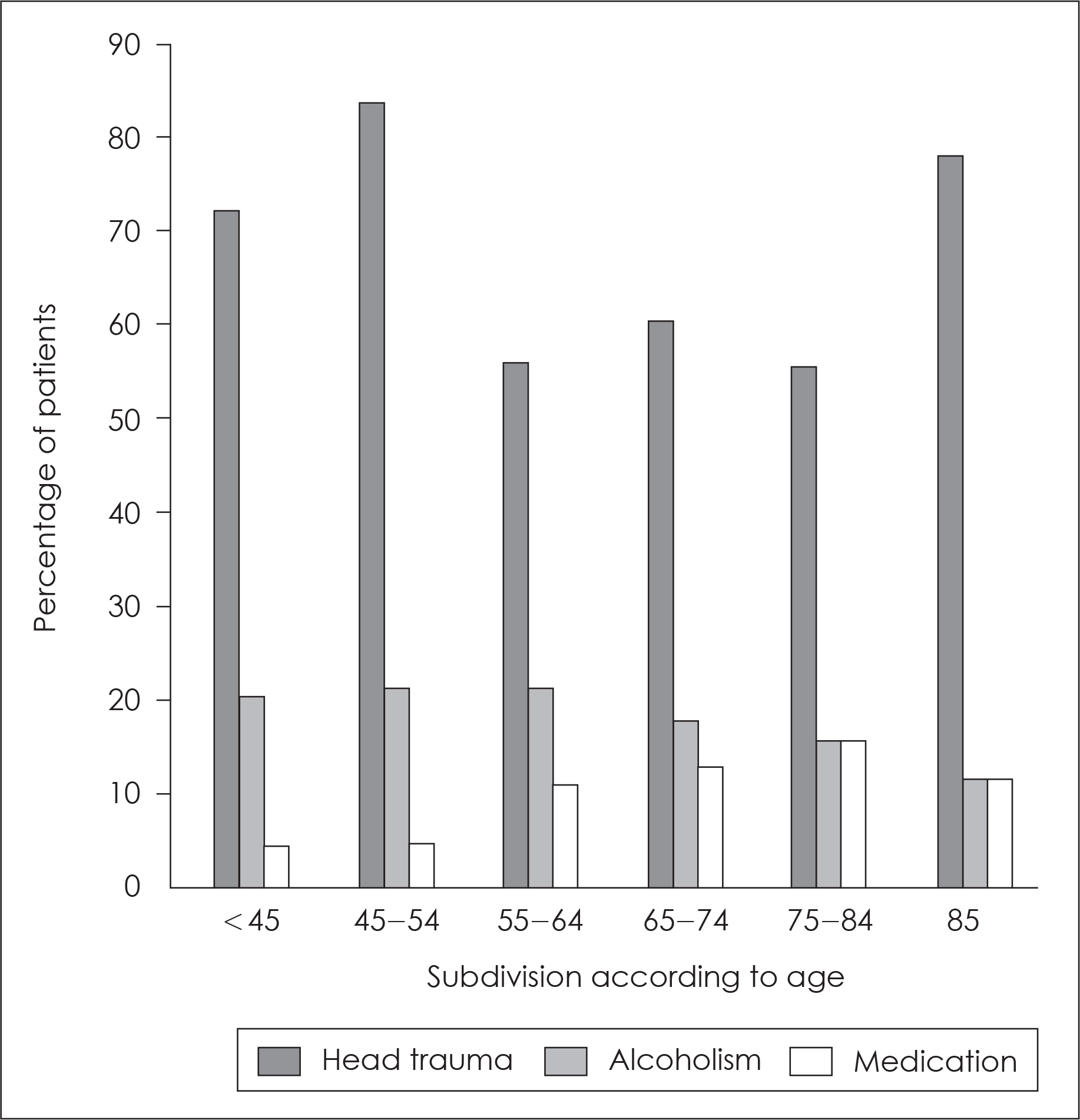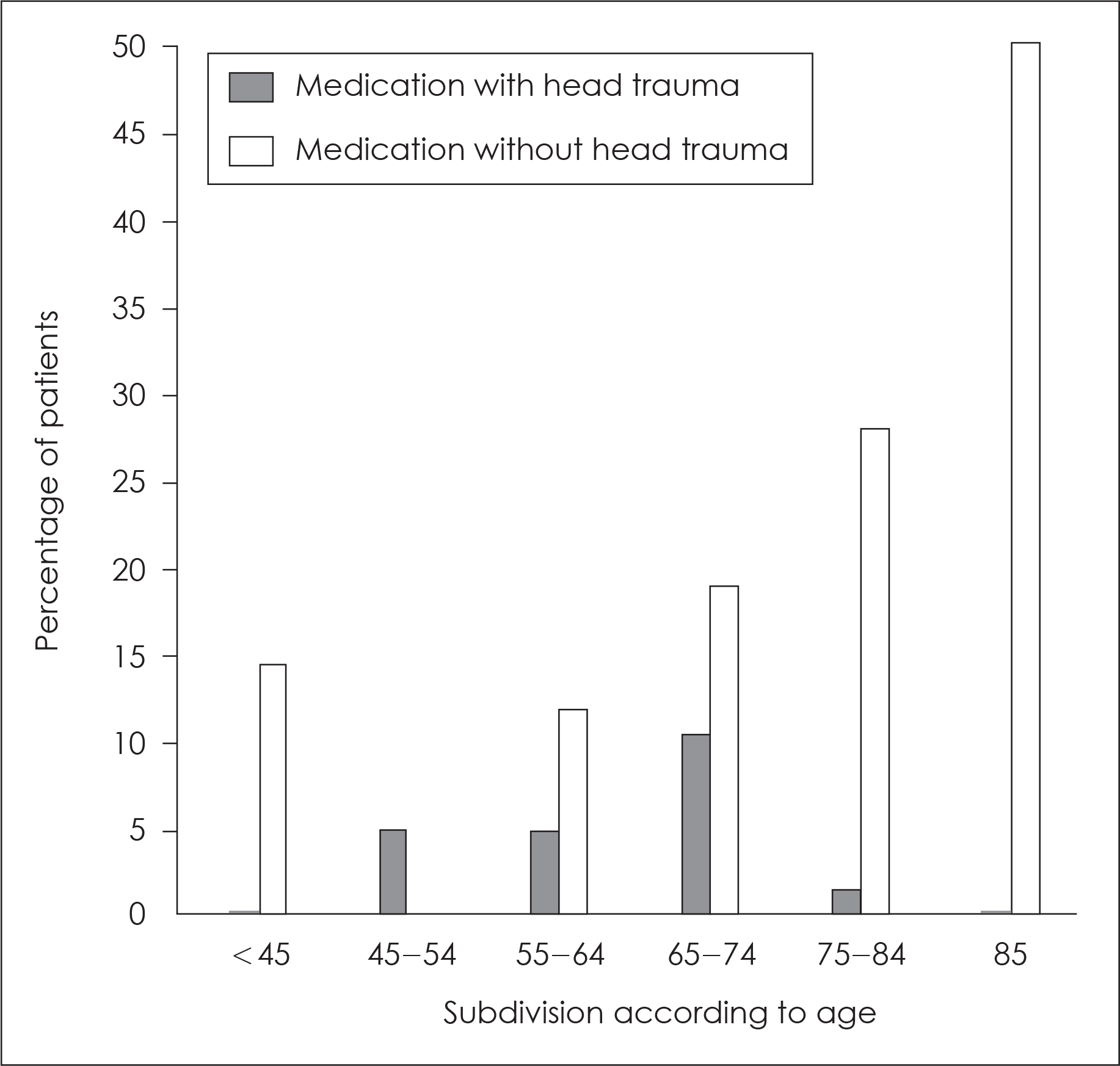Abstract
Objective:
The current understanding reveals that chronic subdural hematoma (CSDH) is mostly the results of direct or indirect head trauma. Other factors such as alcoholism, medication (such as anticoagulants or antiplatelet agents), liver cirrhosis, chronic renal failure and hematologic disease are also well known as causes of CSDH. Of them, the authors attempted to identify the risk factors of CSDH by focusing on the age with a view point of recent increase in the elderly population.
Methods:
We retrospectively reviewed 216 consecutive CSDH patients who underwent surgery at our institute between 2002 and 2011. We classified them into two groups according to the patients’ age (Group A: <65 years old, Group B: ≥65 years old). Various factors were investigated for risk factor of CSDH, such as head trauma, chronic alcoholism, epilepsy, previous shunt surgery, underlying disease having bleeding tendency or medication affecting blood coagulation. And these factors were compared between the two groups for statistical significance.
Results:
Among the 216 patients, group A included 81 patients (37.5%), group B included 135 patients (62.5%). The medication of group B had significantly more proportion than group A, comparing to the result that group B had relatively less proportion of head trauma and alcoholism (p<0.05). And medication was more associated with non-traumatic CSDH, especially in group B.
Go to : 
REFERENCES
1). Baechli H., Nordmann A., Bucher HC., Gratzl O. Demographics and prevalent risk factors of chronic subdural haematoma: results of a large single-center cohort study. Neurosurg Rev. 27:263–266. 2004.

2). Bershad EM., Farhadi S., Suri MF., Feen ES., Hernandez OH., Selman WR, et al. Coagulopathy and inhospital deaths in patients with acute subdural hematoma. J Neurosurg. 109:664–669. 2008.

3). Bleeding during antithrombotic therapy in patients with atrial fi-brillation. The Stroke Prevention in Atrial Fibrillation Investigators. Arch Intern Med. 156:409–416. 1996.
4). Chen JC., Levy ML. Causes, epidemiology, and risk factors of chronic subdural hematoma. Neurosurg Clin N Am. 11:399–406. 2000.

5). Choi WW., Kim KH. Prognostic factors of chronic subdural hematoma. J Korean Neurosurg Soc. 32:18–22. 2002.
6). Drapkin AJ. Chronic subdural hematoma: pathophysiological basis for treatment. Br J Neurosurg. 5:467–473. 1991.

7). Echlin FA., Sordillo SV., Garvey TQ Jr. Acute, subacute, and chronic subdural hematoma. J Am Med Assoc. 161:1345–1350. 1956.

8). Gonugunta V., Buxton N. Warfarin and chronic subdural haematomas. Br J Neurosurg. 15:514–517. 2011.

9). Gorelick PB., Weisman SM. Risk of hemorrhagic stroke with aspirin use: an update. Stroke. 36:1801–1807. 2005.
10). Hart RG., Boop BS., Anderson DC. Oral anticoagulants and intracranial hemorrhage. Facts and hypotheses. Stroke. 26:1471–1477. 1995.
11). Jeong JE., Kim GK., Park JT., Lim YJ., Kim TS., Rhee BA, et al. A clinical analysis of chronic subdural hematoma according to age factor. J Korean Neurosurg Soc. 29:748–753. 2000.
12). Kang HL., Shin HS., Kim TH., Hwang YS., Park SK. Clinical analysis of recurrent chronic subdural hematoma. J Korean Neurosurg Soc. 40:262–266.
13). Kang MS., Koh HS., Kwon HJ., Choi SW., Kim SH., Youm JY. Factors influencing recurrent chronic subdural hematoma after surgery. J Korean Neurosurg Soc. 41:11–15. 2007.
14). Ko BS., Lee JK., Seo BR., Moon SJ., Kim JH., Kim SH. Clinical analysis of risk factors related to recurrent chronic subdural hematoma. J Korean Neurosurg Soc. 43:11–15. 2008.

15). Kotwica Z., Brzeziński J. Chronic subdural haematoma treated by burr holes and closed system drainage: personal experience in 131 patients. Br J Neurosurg. 5:461–465. 1991.

16). Kwon HJ., Youm JY., Kim SH., Koh HS., Song SH., Kim Y. Postoperative radiological changes in chronic subdural hematoma and its relation to recurrence. J Korean Neurosurg Soc. 35:410–414.
17). Lee JK., Choi JH., Kim CH., Lee HK., Moon JG. Chronic subdural hematomas: a comparative study of three types of operative procedures. J Korean Neurosurg Soc. 46:210–214. 2009.
18). Lindvall P., Koskinen LO. Anticoagulants and antiplatelet agents and the risk of development and recurrence of chronic subdural haematomas. J Clin Neurosci. 16:1287–1290. 2009.

20). Mattle H., Kohler S., Huber P., Rohner M., Steinsiepe KF. Anticoagulation-related intracranial extracerebral haemorrhage. J Neurol Neurosurg Psychiatry. 52:829–837. 1989.

21). Mellergård P., Wisten O. Operations and re-operations for chronic subdural haematomas during a 25-year period in a well defined population. Acta Neurochir (Wien). 138:708–713. 1996.
22). Nakaguchi H., Tanishima T., Yoshimasu N. Factors in the natural history of chronic subdural hematomas that influence their postoperative recurrence. J Neurosurg. 95:256–262. 2001.

23). Quinones-Hinojosa A., Gulati M., Singh V., Lawton MT. Spontaneous intracerebral hemorrhage due to coagulation disorders. Neurosurg Focus 15: E3. 2003.

24). Sambasivan M. An overview of chronic subdural hematoma: experience with 2300 cases. Surg Neurol. 47:418–422. 1997.

25). Son WS., Park SH., Kang DH., Park J., Sung JK., Hwang SK. Relationship between the level of fibrinogen and the signal density on brain computed tomography in the chronic subdural hematoma. J Korean Neurotraumatol Soc. 6:43–47. 2010.

26). Spektor S., Agus S., Merkin V., Constantini S. Low-dose aspirin prophylaxis and risk of intracranial hemorrhage in patients older than 60 years of age with mild or moderate head injury: a prospective study. J Neurosurg. 99:661–665. 2003.

27). Torihashi K., Sadamasa N., Yoshida K., Narumi O., Chin M., Yama-gata S. Independent predictors for recurrence of chronic subdural hematoma: a review of 343 consecutive surgical cases. Neurosurgery. 63:1125–1129. discussion 1129. 2008.
28). Weir B., Gordon P. Factors affecting coagulation: fibrinolysis in chronic subdural fluid collections. J Neurosurg. 58:242–245. 1983.

Go to : 
 | FIGURE 1.The risk factors of CSDH in 216 patients subdivided according to age and percentage of patients with each risk factor. CSDH: chronic subdural hematoma. |
 | FIGURE 2.The percentage of medication as risk factor of CS-DH subdivided according to age and head trauma history. CSDH: chronic subdural hematoma. |
TABLE 1.
Markwalder's neurologic grading system (Marwalder19))
TABLE 2.
Characteristics and clinical findings of 216 patients with CSDH
TABLE 3.
Risk factors of CSDH in 216 patients
| Group | Group A (n=81) | Group B (n=135) No. of patients (%) | Total (n=216) | p-value |
|---|---|---|---|---|
| Risk factors | ||||
| Head trauma | 56 (69.1) | 80 (59.3) | 136 (55.3) | 0.190 |
| Chronic alcoholism | 17 (21.0) | 22 (16.3) | 39 (18.1) | 0.465 |
| Medication∗ | 5 (6.2) | 18 (13.3) | 23 (10.6) | 0.045 |
| Previous shunt surgery | 2 (2.5) | 3 (2.2) | 5 (2.3) | 0.848 |
| Epilepsy | 0 (0.0) | 1 (0.7) | 1 (0.4) | - |
| Coagulopathy† | 4 (4.9) | 5 (3.7) | 9 (4.2) | 0.731 |
| Unknown‡ | 12 (14.8) | 22 (16.3) | 34 (15.7) | 0.848 |
Statistical analysis was performed with Fisher's exact test. ∗antiplatelet agents (including aspirin, clopidogrel, or trifulsal) or anticoagulants (warfarin),
TABLE 4.
Cause of CSDH in Group A and B with head trauma history
TABLE 5.
Cause of CSDH in Group A and B without head trauma history
| Trauma (-) | In group A (n=25) | In group B (n=55) | p-value |
|---|---|---|---|
| No. of patients (%) | |||
| Risk factors | |||
| Chronic alcoholism | 6 (24.0) | 13(23.6) | 1.000 |
| Medication∗ | 2 (8.0) | 12(21.8) | 0.205 |
| Previous shunt surgery | 1 (4.0) | 3 (5.5) | 0.627 |
| Epilepsy | 0 (0.0) | 0 (0.0) | - |
| Coagulopathy† | 3 (12.0) | 3 (5.5) | 0.370 |




 PDF
PDF ePub
ePub Citation
Citation Print
Print


 XML Download
XML Download